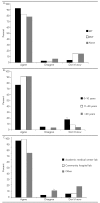Knowledge and perceptions of quality systems among Vermont laboratorians
- PMID: 20518447
- PMCID: PMC2846805
- DOI: 10.1177/00333549101250S209
Knowledge and perceptions of quality systems among Vermont laboratorians
Abstract
Objectives: This article reports on a survey of medical laboratorians' knowledge of quality systems in their workplace and their perceptions about the effect of job function, education and training, professional credentials, and experience on the overall quality of testing and results.
Methods: The Medical Laboratory Workforce Survey was designed and conducted in Vermont in 2005. Surveys were distributed to all laboratorians working in Clinical Laboratory Improvement Amendments-regulated laboratories throughout Vermont. Results were analyzed for statistical significance using the Fisher's exact test for overall group comparisons.
Results: Laboratorians perceived that they were generally knowledgeable about the quality systems in place in their laboratories (96% considered themselves familiar with quality assurance [OA] measures in their laboratory), but meeting quality objectives and perceptions of factors that impact quality measures in the laboratory were variably influenced by the laboratorians' years of experience, professional credentials, organization type, and job title. Almost half (47%) of laboratorians said they did not have a role in deciding the QA measures, whereas 77% felt they had a significant impact on meeting the QA objectives.
Conclusions: Not all laboratorians feel that they play a significant role in assuring quality or influencing quality measures used in the laboratory. All laboratorians should be encouraged to take an active approach to influence quality systems in the laboratory to ensure the highest quality health care possible.
Figures









References
-
- Department of Labor (US), Bureau of Labor Statistics. Occupational outlook handbook, 2008-09 edition. [cited 2009 Mar 5]. Available from: URL: http://www.bls.gov/oco/ocos096.htm.
-
- Quillen K, Murphy K. Quality improvement to decrease specimen mislabeling in transfusion medicine. Arch Pathol Lab Med. 2006;130:1196–8. - PubMed
-
- Favaloro EJ, Lippi G, Adcock DM. Preanalytical and postanalytical variables: the leading causes of diagnostic error in homeostasis? Semin Thromb Hemost. 2008;34:612–34. - PubMed
-
- Howanitz PJ. Errors in laboratory medicine: practical lessons to improve patient safety. Arch Pathol Lab Med. 2005;129:1252–61. - PubMed
-
- Kalra J. Medical errors: impact on clinical laboratories and other critical areas. Clin Biochem. 2004;37:1052–62. - PubMed
Publication types
MeSH terms
Grants and funding
LinkOut - more resources
Full Text Sources
Medical

